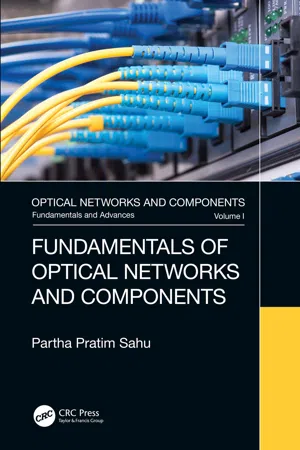
- 364 pages
- English
- ePUB (mobile friendly)
- Available on iOS & Android
Fundamentals of Optical Networks and Components
About This Book
This book is intended as an undergraduate/postgraduate level textbook for courses on high-speed optical networks as well as computer networks. Nine chapters cover the basic principles of the technology and different devices for optical networks, as well as processing of integrated waveguide devices of optical networks using different technologies. It provides students, researchers and practicing engineers with an expert guide to the fundamental concepts, issues and state-of-the-art developments in optical networks. It includes examples throughout all the chapters of the book to aid understanding of basic problems and solutions.
-
- Presents basics of the optical network devices and discusses latest developments
-
- Includes examples and exercises throughout all the chapters of the book to aid understanding of basic problems and solutions for undergraduate and postgraduate students
-
- Discusses different optical network node architectures and their components
-
- Includes basic theories and latest developments of hardware devices with their fabrication technologies (such as optical switch, wavelength router, wavelength division multiplexer/demultiplexer and add/drop multiplexer), helpful for researchers to initiate research on this field and to develop research problem-solving capability
-
- Reviews fiber-optic networks without WDM and single-hop and multi-hop WDM optical networks
P. P. Sahu received his M.Tech. degree from the Indian Institute of Technology Delhi and his Ph.D. degree in engineering from Jadavpur University, India. In 1991, he joined Haryana State Electronics Development Corporation Limited, where he has been engaged in R&D works related to optical fiber components and telecommunication instruments. In 1996, he joined Northeastern Regional Institute of Science and Technology as a faculty member. At present, he is working as a professor in the Department of Electronics and Communication Engineering, Tezpur Central University, India. His field of interest is integrated optic and electronic circuits, wireless and optical communication, clinical instrumentation, green energy, etc. He has received an INSA teacher award (instituted by the highest academic body Indian National Science Academy) for high level of teaching and research. He has published more than 90 papers in peer-reviewed international journals, 60 papers in international conference, and has written five books published by Springer Nature, McGraw-Hill. Dr Sahu is a Fellow of the Optical Society of India, Life Member of Indian Society for Technical Education and Senior Member of the IEEE.
Frequently asked questions
Information
1 Introductory Concept
1.1 Basic Communication Model

1.1.1 Local Area Network
1.1.1.1 OSI Model
- Physical layer: It permits interconnection with different control procedures such as V.24 and V.25 for various physical media.
- Data link layer: It controls data transmission through the system having high error rate (i.e., an error rate not acceptable for a great majority of applications). It works in the framework of high-level data link control (HDLC). It is just above the physical layer.
- Network layer: It selects a connection path or provides a rout (where the intermediate nodes may be present) for data transmission from one node to the other.
- Transport layer: It controls successful transportation of data from the source to the destination node. It provides totality of transmission service and ensures that data are delivered error-free, in sequences with no loss and delicacy.
- Session layer: It provides synchronization or organization dialog between the source and the destination before data transmission. It does function above the transport layer. It provides a mechanism for recovery and permits backup.
- Presentation layer: It does general interest functions related to representation and manipulation of structured data just before the application layer. It defines the format of the data to be exchanged between different applications.
- Application layer: It performs management functions and generally useful mechanisms that support distributed applications.
1.1.1.2 TCP/IP Protocol
- Physical layer: It defines the characteristics of transmission medium, signaling rate and encoding scheme.
- Network access layer: It makes a logical interface between an end system and a subnetwork where a connection path is selected.
- Internet layer: It does the function of routing data from the source node to the destination host through one or more networks connected by routers.
- Host-to-host transport layer.
- Application layer.
Table of contents
- Cover
- Half Title
- Title Page
- Copyright Page
- Dedication
- Table of Contents
- Preface
- Acknowledgements
- Author
- Chapter 1 Introductory Concept
- Chapter 2 Different Optical Network Node
- Chapter 3 Devices in Optical Network Node
- Chapter 4 Processing of Integrated Waveguide Devices for Optical Network Using Different Technologies
- Chapter 5 Data Link Control for Optical Network
- Chapter 6 Data Communication Networks Having No Optical Transmission
- Chapter 7 Fiber-Optic Network without WDM
- Chapter 8 Single-Hop and Multihop WDM Optical Networks
- Chapter 9 Optical Access Architecture
- Index